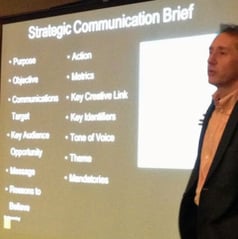It’s easy to abandon fundamental practices we all know are the right thing to do when there are too many time pressures, too much work to get done, and too few options to cope. Those situations are when cutting corners often leads to eliminating practices to save time initially, only to pay for it with more time and problems later on in your process.
One easily abandoned tool is using a strategic creative brief to launch communications projects.
Asking both clients and attendees at Brainzooming presentations, too many people either admitted they used to use strategic creative briefs but don’t much anymore or had never heard of using them.
4 Benefits of Using a Strategic Creative Brief
 The strategic creative brief is a great tool to achieve various benefits. Developing and using a strategic communication brief to launch a new effort:
The strategic creative brief is a great tool to achieve various benefits. Developing and using a strategic communication brief to launch a new effort:
- Stimulates initial strategic conversations and expectation setting
- Documents expectations for the communications effort
- Permits those developing the communications piece(s) to perform better and apply their creativity within the guidelines laid out
- Allows you to more objectively judge whether the communication piece is delivering on expectations
One other related advantage from having a strategic creative brief prepared in advance is it helps minimize “I like / I don’t like” conversations when evaluating a creative piece. Without upfront documentation on what the piece is trying to do, assessing its quality typically devolves into who can win the personal preference wrestling match. Avoiding this is especially important when the people sharing personal preferences aren’t part of the target audience for the creative piece anyway.
We use strategic creative briefs with clients on both traditional marketing communications efforts and on social media content efforts. The brief may be developed for a single communications piece, or it can serve as the foundation for a campaign or series of communications pieces (such as for a collaborative blog with many posts from multiple contributors).
3 Things to Include in a Strategic Creative Brief
We vary each one we develop for clients based on the particular types of communications efforts they’ll be addressing most frequently. Generally, you can think about three categories of information to include on the strategic creative brief:
- Objectives – Details where you want to go with the project (goals; audience definition, preferences, and call to action; metrics, etc.)
- Preferences – Details what you want it to be (brand standards; messaging; creative elements, etc.)
- Guidelines – Details what you don’t want the project to be (Acceptable tone and look; mandatory elements, etc.)
Using this more general description (objective, preferences, and guidelines) opens up the concept to how a strategic brief can be used to launch non-communications efforts with greater clarity and better input for project teams.
Is your organization effectively using a strategic creative brief?
What types of additional benefits do you find if your organization is using them? And if you’ve stopped using them, how do you view reintroducing them into your communications process? - Mike Brown




